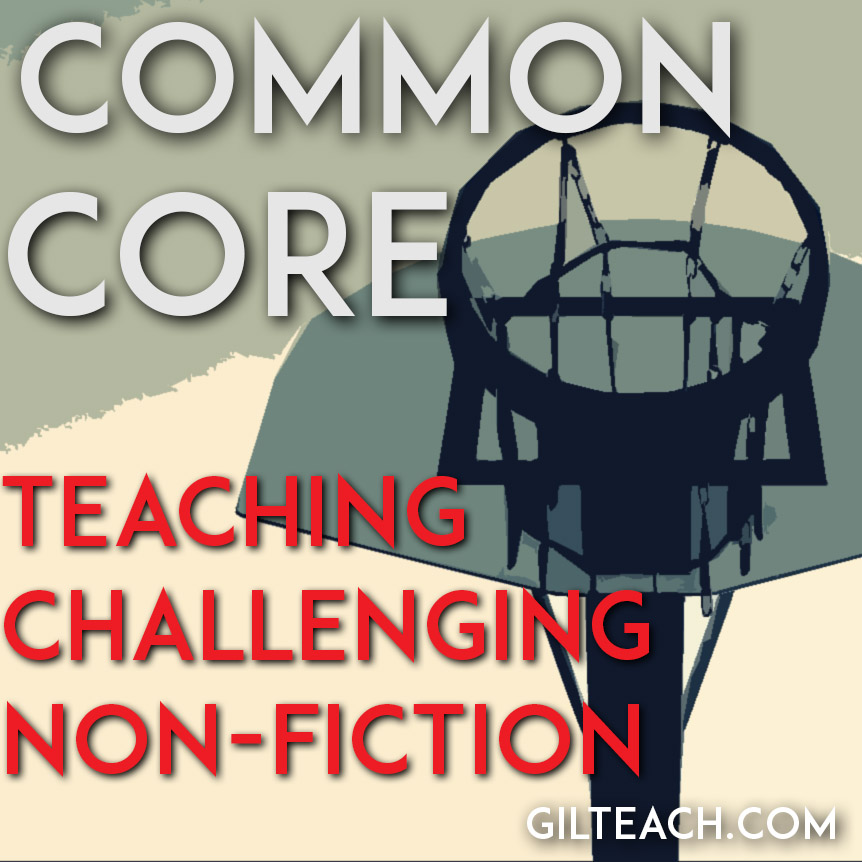Common Core: 3 Tips for Teaching With Challenging Non-Fiction

Whether I’m assigning an article about the relationship between a fixed mindset and the Enron scandal or I’m requiring students to read an essay about how basketball, race, and dreams are all intertwined, I have a few common goals when I choose challenging non-fiction to incorporate in my lesson plans.
I want students to learn how to deal with difficult vocabulary, how to navigate complex sentence structure sentence structure, and most importantly, I want them to learn how to question the ideas that they read and their own beliefs.

These are three main characteristics that make a text challenging and my suggestions for how to get your students through those challenges.
1. Challenging texts have difficult vocabulary. In spite of what many of my students often assert, good writers don’t just throw in a bunch of hard words because it looks impressive. Quality nonfiction uses difficult vocabulary for a few reasons. For one, the words that students are less likely to know are often the most precise words for the context. Words like demilitarization, detente, conservative, and radical are all necessary for describing historical movements or philosophies. There just aren’t simple synonyms that express the same ideas. Another reason why challenging non-fiction often contains lots of big words is because the ideas are more complex. When you are attempting to explain the economic effect of drought on African nations or the way that Jane Austen’s later novels signal a transition to the Romantic era, you can’t do that with a simple vocabulary.
Students need to learn the words that matter and not worry about the ones that don’t. The first task for students is to choose the important words and learn them. If the entire article is about the disillusionment of the millennial generation and students don’t know what “disillusionment” means, they’ll have a rough time with the piece. In my experience, students are pretty adept at realizing which words are important. The other important piece for students to learn is which words actually don’t matter at all. I have found that the best, most experienced readers in my classes are pretty good at reading texts when they don’t fully understand the definition of every single word. So teaching students to understand the context, the main idea, and the important points without necessarily being able to give a dictionary definition of every single word is key.
2. Challenging texts have complex sentences or other rhetorical elements. The best non fiction is straightforwardly factual and informative, but it also contains at least a few sentences that will need to be read and reread in order to be understood. Good writers know how to make an impression on a reader, and one way that they do this is with what I often call special sentences. These are the points where the reader is taken out of the piece, where an especially vivid description, or a striking metaphor, or an intricately constructed sentence call attention to the writing.
Students need to learn how to break down those sentences for meaning. I’ve found that giving students specific questions that ask about the different parts of the sentences go a long way towards helping them understand the author’s purpose. And helping students to identify these special sentences and to understand how they contribute to meaning is key. With the new common core standards, it’s not enough to guess at the main idea anymore. Now students will have to explain how that meaning is created, so get them to understand the reasons behind the author’s choices by asking them to find those special sentences and think about what meaning is created by them.
3. Challenging texts question as much as they inform. We all know how to look for the main idea of a text. That’s definitely important and a necessary step towards understanding what the author is saying. But all good nonfiction questions those ideas as much as it explains them. You know that your choice qualifies as a good example of challenging nonfiction if it gives you lots of answers but it also makes you question what you already believed. So I might give my students an essay about the Enron scandal but what I really want is for them to think about the effect of a fixed mindset on their own lives, or I might give them a piece on basketball, but what I hope is that they start to think about their own dreams.
To me, this is the best part of using good writing in the classroom. One of my biggest goals is to get students to think for themselves. Teaching them to read deeply on a subject and question everything they know about it is the best way that I know to create independent thinkers.